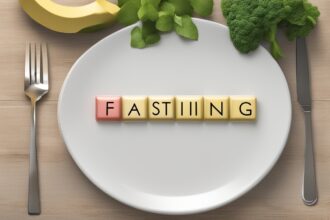Intermittent fasting (IF) has gained immense popularity as a powerful strategy for weight loss and overall health improvement. Unlike traditional diets that focus on what to eat, intermittent fasting emphasizes when to eat, making it a flexible and sustainable approach to slimming down. In this comprehensive guide, we’ll explore the concept of Sustainable Slimming with Intermittent Fasting, diving into its benefits, methods, and practical tips to help you achieve long-term weight loss success without feeling deprived.
What Is Intermittent Fasting and How Does It Promote Sustainable Slimming?
Intermittent fasting is an eating pattern that cycles between periods of fasting and eating. Rather than restricting specific foods, it focuses on timing your meals to allow your body to tap into stored fat for energy during fasting periods. Popular methods include the 16/8 method (fasting for 16 hours and eating during an 8-hour window) and the 5:2 diet (eating normally for five days and reducing calorie intake on two non-consecutive days). This approach aligns with sustainable slimming because it doesn’t require drastic calorie cuts or eliminating entire food groups, which often lead to burnout in traditional diets.
During fasting, your body undergoes metabolic changes, such as increased fat-burning and improved insulin sensitivity, which can support weight loss. Additionally, IF naturally reduces calorie intake by limiting the time you have to eat, making it easier to maintain a calorie deficit without constant hunger. For more on how fasting impacts metabolism, check out our detailed post on Metabolism and Fasting: What You Need to Know.
Key Benefits of Intermittent Fasting for Sustainable Weight Loss
Intermittent fasting offers numerous benefits beyond just shedding pounds, making it a holistic approach to sustainable slimming. First, it simplifies eating patterns, reducing decision fatigue around meals. With fewer eating windows, you’re less likely to overeat or indulge in unplanned snacking. Second, IF can improve hormonal balance by lowering insulin levels and boosting human growth hormone (HGH), both of which aid in fat loss and muscle preservation.
Moreover, intermittent fasting has been shown to reduce inflammation and improve gut health, which are critical for maintaining a healthy weight long-term. Unlike fad diets that promise quick results but fail to deliver sustainability, IF encourages mindful eating and can be adapted to fit any lifestyle. Curious about how IF compares to other diets? Read our comparison in Intermittent Fasting vs. Keto: Which Is Better for You?.
Popular Intermittent Fasting Methods for Sustainable Slimming
There are several intermittent fasting protocols to choose from, each offering flexibility to suit different needs and goals. Here are a few popular methods:
- 16/8 Method: Fast for 16 hours and eat during an 8-hour window (e.g., eating between 12 PM and 8 PM). This is ideal for beginners due to its simplicity.
- 5:2 Diet: Eat normally for five days of the week and restrict calories to 500–600 on two non-consecutive days. This method works well for those who prefer minimal fasting.
- Eat-Stop-Eat: Involves a 24-hour fast once or twice a week. It’s more challenging but can yield significant results for experienced fasters.
Choosing the right method depends on your schedule, hunger tolerance, and weight loss goals. The key to sustainable slimming with intermittent fasting is starting slow and gradually adjusting to longer fasting periods. For tips on easing into IF, explore our guide on Beginner’s Guide to Fasting.
Tips for Success with Intermittent Fasting
While intermittent fasting is relatively straightforward, adopting it for sustainable slimming requires some preparation and mindfulness. Here are actionable tips to maximize your results:
- Stay Hydrated: Drink plenty of water during fasting periods to curb hunger and support detoxification. Herbal teas and black coffee (without sugar) are also great options.
- Eat Nutrient-Dense Foods: Focus on whole, unprocessed foods like vegetables, lean proteins, and healthy fats during eating windows to fuel your body effectively.
- Listen to Your Body: If you feel excessively hungry or fatigued, adjust your fasting schedule or consult a healthcare professional to ensure you’re not overdoing it.
- Pair with Exercise: Light activities like walking or yoga during fasting can enhance fat-burning, while strength training during eating windows helps preserve muscle mass.
Consistency is key to sustainable slimming with intermittent fasting, so avoid viewing it as a quick fix. Instead, treat it as a long-term lifestyle change. For workout ideas that complement IF, see our post on Exercise and Fasting: Best Practices.
Common Challenges and How to Overcome Them
While intermittent fasting can be highly effective, it’s not without challenges, especially for beginners. Hunger pangs, irritability, and social eating pressures are common hurdles. To manage hunger, start with shorter fasting windows and gradually increase them as your body adapts. Keeping busy during fasting periods can also distract from cravings—try engaging in hobbies or light exercise.
Social situations, like dining out or family gatherings, can disrupt your fasting schedule. Plan ahead by choosing a flexible IF method or shifting your eating window to accommodate events. If you’re struggling with cravings, read our article on Managing Cravings During Fasting for practical strategies to stay on track.
Is Intermittent Fasting Right for Everyone?
While intermittent fasting is a powerful tool for sustainable slimming, it’s not suitable for everyone. Individuals with certain medical conditions, such as diabetes, eating disorders, or pregnancy, should consult a healthcare provider before starting IF. Additionally, fasting may not be ideal for those with high stress levels or irregular schedules that make consistent fasting difficult.
It’s important to approach IF with realistic expectations and prioritize overall health over rapid weight loss. Sustainable slimming with intermittent fasting works best when tailored to your unique needs and lifestyle, so don’t hesitate to seek professional guidance if needed.
Disclaimer: The information provided in this article is for educational purposes only and should not be considered medical advice. Intermittent fasting may not be suitable for everyone, and results can vary based on individual health conditions and lifestyle factors. Always consult with a healthcare professional or registered dietitian before starting any new diet or fasting regimen to ensure it is safe and appropriate for your specific needs.
References
- Harvard Health Publishing: Intermittent Fasting: Surprising Update
- Mayo Clinic: Intermittent Fasting FAQ
- New England Journal of Medicine: Effects of Intermittent Fasting on Health, Aging, and Disease
- National Institutes of Health: Intermittent Fasting and Weight Loss
- WebMD: What Is Intermittent Fasting?
This content is for informational purposes only and not a substitute for professional advice.






